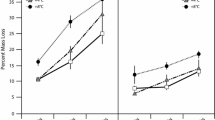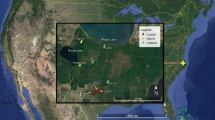Abstract
Reservoirs are sources of greenhouses gases to the atmosphere, primarily due to organic carbon mineralization in flooded plants and soils to carbon dioxide (CO2) and methane (CH4). Floating peat islands are common in reservoirs that inundated peatlands. These islands can decompose on mass, or small pieces of peat can erode from islands to decompose in the water column or on the bottom of reservoirs. Here we used large 450 liter sealed enclosures to measure mineralization rates of small peat pieces and larger peat blocks collected from floating peat islands. Mineralization rates were calculated by quantifying dissolved inorganic carbon (DIC), CO2 and CH4 accumulation within the water and headspace of the enclosures over time. We found that peat did decompose under water, but rates of mineralization of peat pieces were not different than rates of mineralization of larger peat blocks. Mineralization rates ranged between 59 and l40 μg C g−1 d−1. Peat pieces acidified the water, shifting the bicarbonate equilibrium to almost exclusively dissolved CO2, which was then readily able to flux to the atmosphere. We estimated that 2.4–5.6% of peat carbon was mineralized annually, suggesting that fluxes of CO2 and CH4 from reservoirs that flood peatlands could last at minimum 18–42 years from this carbon source alone.
Similar content being viewed by others
References
Bergman I., Lundberg P. and Nilsson N. 1999. Microbial carbon mineralization in an acid surface peat: effects of environmental factors in laboratory incubations. Soil Biol. Biochem. 31: 1867–1877.
Bridgham S.D., Updegraff K. and Pastor J. 1998. Carbon, nitrogen, and phosphorus mineralization in northern wetlands. Ecol. 79: 1545–1561.
Colket M.B., Naegeli D.W., Dryer F.L. and Glassman I. 1974. Flame ionization detection of carbon oxides and hydrocarbon oxygenates. Environ. Sci. Technol. 8: 43–46.
Duchemin E., Lucotte M., Canuel R. and Chamberland A. 1995. Production of the greenhouse gases CH4 and CO2 by hydroelectric reservoirs of the boreal region. Global Biogeochem. Cycles 9: 529–540.
Gorham E. 1991. Northern peatlands: role in the carbon cycle and probable responses to climatic warming. Ecol. Appl. 1: 182–195.
Hamilton J.D., Kelly C.A., Rudd J.W.M., Hesslein R.H. and Roulet N.T. 1994. Flux to the atmosphere of CH4 and CO2 from wetland ponds on the Hudson Bay lowlands (HBLs). J. Geophys. Res. 99: 1495–1510.
Hogg E.H. 1993. Decay potential of hummock and hollow Sphagnum peats at different depths in a Swedish raised bog. Oikos 66: 269–278.
Houghton J.T., Meira Filho L.G., Callander B.A., Harris N., Kattenberg A. and Maskell K. (eds) 1995. Climate Change 1995: The Science of Climate Change. Cambridge University Press, Cambridge, UK.
Kelly C.A., Rudd J.W.M., St.Louis V.L. and Moore T. 1994. Turning attention to reservoir surfaces, a neglected area in greenhouse studies. EOS 75: 332–333.
Kelly C.A., Rudd J.W.M., Bodaly R.A., Roulet N.T., St.Louis V.L., Heyes A. et al. 1997. Increases in fluxes of greenhouse gases and methyl mercury following flooding of an experimental reservoir. Environ. Sci. Technol. 31: 1334–1344.
Koskenniemi E. 1987. Development of floating peat and macrophyte vegetation in a newly created, polyhumic reservoir, western Finland. Aqua Fennica 17: 165–173.
Magnusson T. 1993. Carbon dioxide and methane formation in forest mineral and peat soils during aerobic and anaerobic incubations. Soil Biol. Biochem. 25: 877–883.
McKenzie C., Schiff S., Aravena R., Kelly C. and St.Louis V. 1998. Effects of temperature on production of CH4 and CO2 from peat in a natural and flooded boreal forest wetland. Climate Change 40: 247–266.
Moore T.R. and Dalva M. 1997. Methane and carbon dioxide exchange potentials of peat soils in aerobic and anaerobic laboratory incubations. Soil Biol. Biochem. 8: 1157–1164.
Ronka E. and Uusinoka R. 1976. The problem of peat upheaval in Finnish artificial reservoirs. Bull. Int. Assoc. Engin. Geol. l4: 11–14.
Rudd J.W.M., Harris R., Kelly C.A. and Hecky R.E. 1993. Are hydroelectric reservoirs significant sources of greenhouse gases? Ambio 22: 246–248.
Scott K., Kelly C. and Rudd J.W.M. 1999. The importance of floating peat to methane fluxes from flooding peatlands. Biogeochem. 47: 187–202.
St.Louis V.L., Kelly C.A., Duchemin E., Rudd J.W.M. and Rosenberg D.M. 2000. Reservoir surfaces as sources of greenhouse gases to the atmosphere: a global estimate. BioScience 50: 766–775.
Stainton M.P., Capel M.J. and Armstrong F.A.J. 1977. Chemical analysis of fresh water. 2nd edn. Fish Mar. Serv. Misc. Spec. Publ. 25, 166 p.
Turetsky M.R., Weider R.K., Williams C.J. and Vitt D.H. 2000. Organic matter accumulation, peat chemistry, and permafrost melting in peatlands of boreal Alberta. Ecoscience 7: 379–392.
Williams C.J., Yavitt J.B., Weider R.K. and Cleavitt N.L. 1998. Cupric oxidation products of northern peat and peat-forming plants. Can. J. Bot. 76: 51–62.
Yavitt J.B., Williams C.J. and Wieder R.K. 2000. Controls on the microbial production of methane and carbon dioxide in three Sphagnum-dominated peatland ecosystems as revealed by a reciprocal field peat transplant experiment. Geomicrobiol J. 17: 61–88.
Rights and permissions
About this article
Cite this article
St. Louis, V.L., Partridge, A.D., Kelly, C.A. et al. Mineralization rates of peat from eroding peat islands in reservoirs. Biogeochemistry 64, 97–110 (2003). https://doi.org/10.1023/A:1024982915493
Issue Date:
DOI: https://doi.org/10.1023/A:1024982915493




